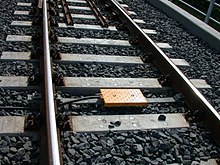
Back ETCS Catalan European Train Control System Czech European Train Control System Danish European Train Control System German Ευρωπαϊκό Σύστημα Ελέγχου Αμαξοστοιχιών Greek Sistema de control ferroviario europeo Spanish Eurooppalainen junien kulunvalvontajärjestelmä Finnish Système européen de contrôle des trains French ETCS Croatian ETCS Hungarian
This article needs to be updated. (June 2022) |

| Automated track-bound traffic |
|---|
| Automatic train operation |
| Lists of automated train systems |
| Related topics |
The European Train Control System (ETCS) is a train protection system designed to replace the many incompatible systems used by European railways, and railways outside of Europe. ETCS is the signalling and control component of the European Rail Traffic Management System (ERTMS).
ETCS consists of 2 major parts:
- trackside equipment
- on-board (on train) equipment
ETCS can allow all trackside information to be passed to the driver cab, removing the need for trackside signals. This is the foundation for future automatic train operation (ATO). Trackside equipment aims to exchange information with the vehicle for safely supervising train circulation.[1] The information exchanged between track and trains can be either continuous or intermittent according to the ERTMS/ETCS level of application and to the nature of the information itself.[1]
The need for a system like ETCS stems from more and longer running trains resulting from economic integration of the European Union (EU) and the liberalisation of national railway markets. At the beginning of the 1990s there were some national high speed train projects supported by the EU which lacked interoperability of trains. This catalysed the Directive 1996/48 about the interoperability of high-speed trains, followed by Directive 2001/16 extending the concept of interoperability to the conventional rail system. ETCS specifications have become part of, or are referred to, the Technical Specifications for Interoperability (TSI) for (railway) control-command systems, pieces of European legislation managed by the European Union Agency for Railways (ERA). It is a legal requirement that all new, upgraded or renewed tracks and rolling stock in the European railway system should adopt ETCS, possibly keeping legacy systems for backward compatibility. Many networks outside the EU have also adopted ETCS, generally for high-speed rail projects. The main goal of achieving interoperability had mixed success in the beginning.
Deployment has been slow, as there is no business case for replacing existing train protection systems,[2] especially in Germany and France which already had advanced train protection systems installed in most mainlines. Even though these legacy systems were developed in the 1960s, they provided similar performance to ETCS Level 2, thus the reluctance of infrastructure managers to replace these systems with ETCS. There are also significant problems regarding compatibility of the latest software releases or baselines of infrastructure-side equipment with older on-board equipment, forcing in many cases the train operating companies to replace ETCS equipment after only a few years.[3] Switzerland, an early adopter of ETCS Limited Supervision, has introduced a moratorium on its planned roll-out of ETCS Level 2 due to cost and capacity concerns, added to fears about GSM-R obsolescence starting in 2030.[4][5]
- ^ a b Cite error: The named reference
:2was invoked but never defined (see the help page). - ^ Briginshaw, David. "Will digitalisation spur ETCS deployment in Europe?". Retrieved 4 June 2018.
- ^ Vosman, Quintus. "DB Cargo to equip 1200 locomotives with ETCS". Retrieved 4 June 2018.
- ^ "SmartRail 4.0 pilot within three years". Railway Gazette International. 12 November 2018. Retrieved 23 October 2019.
- ^ "Rail Communications (RT)". ETSI. Retrieved 23 October 2019.
© MMXXIII Rich X Search. We shall prevail. All rights reserved. Rich X Search